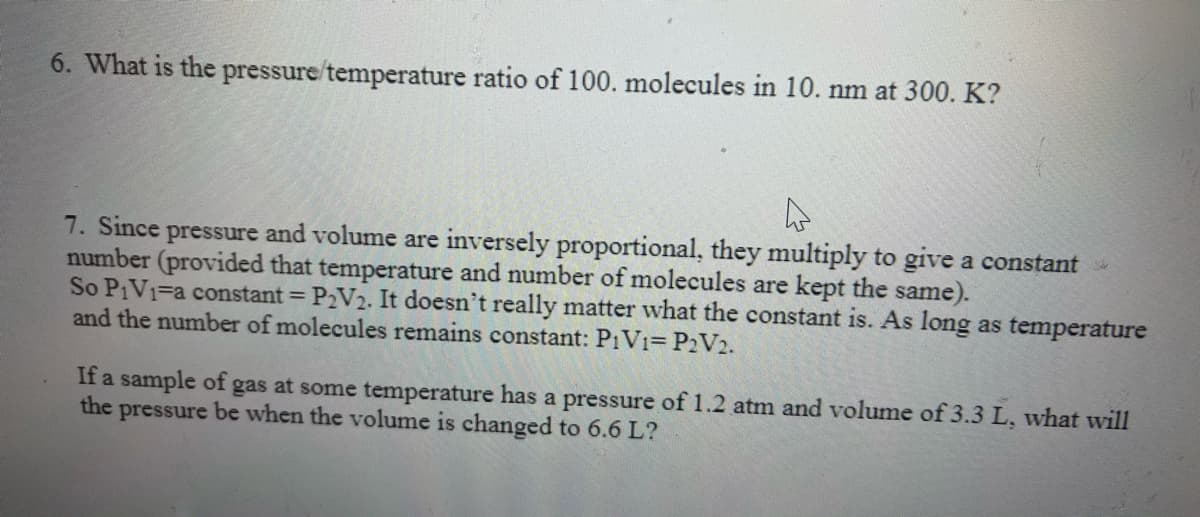6. What is the pressure/temperature ratio of 100. molecules in 10. nm at 300. K? 7. Since pressure and volume are inversely proportional, they multiply to give a constant number (provided that temperature and number of molecules are kept the same). So PIV1=a constant = P2V2. It doesn't really matter what the constant is. As long as temperature and the number of molecules remains constant: P1V1= P2V2. If a sample of gas at some temperature has a pressure of 1.2 atm and volume of 3.3 L, what will the pressure be when the volume is changed to 6.6 L?
6. What is the pressure/temperature ratio of 100. molecules in 10. nm at 300. K? 7. Since pressure and volume are inversely proportional, they multiply to give a constant number (provided that temperature and number of molecules are kept the same). So PIV1=a constant = P2V2. It doesn't really matter what the constant is. As long as temperature and the number of molecules remains constant: P1V1= P2V2. If a sample of gas at some temperature has a pressure of 1.2 atm and volume of 3.3 L, what will the pressure be when the volume is changed to 6.6 L?
General Chemistry - Standalone book (MindTap Course List)
11th Edition
ISBN:9781305580343
Author:Steven D. Gammon, Ebbing, Darrell Ebbing, Steven D., Darrell; Gammon, Darrell Ebbing; Steven D. Gammon, Darrell D.; Gammon, Ebbing; Steven D. Gammon; Darrell
Publisher:Steven D. Gammon, Ebbing, Darrell Ebbing, Steven D., Darrell; Gammon, Darrell Ebbing; Steven D. Gammon, Darrell D.; Gammon, Ebbing; Steven D. Gammon; Darrell
Chapter5: The Gaseous State
Section: Chapter Questions
Problem 5.106QP: The density of air at 20C and 1.00 atm is 1.205 g/L. If this air were compressed at the same...
Related questions
Question
I know you guys only solve up to three sub parts but plz plz solve it for me... may you have the best day of your life

Transcribed Image Text:6. What is the pressure/temperature ratio of 100. molecules in 10. nm at 300. K?
7. Since pressure and volume are inversely proportional, they multiply to give a constant
number (provided that temperature and number of molecules are kept the same).
So PIV1=a constant = P2V2. It doesn't really matter what the constant is. As long as temperature
and the number of molecules remains constant: P1V1= P2V2.
If a sample of gas at some temperature has a pressure of 1.2 atm and volume of 3.3 L, what will
the
pressure be when the volume is changed to 6.6 L?
Expert Solution
This question has been solved!
Explore an expertly crafted, step-by-step solution for a thorough understanding of key concepts.
This is a popular solution!
Trending now
This is a popular solution!
Step by step
Solved in 2 steps with 1 images

Knowledge Booster
Learn more about
Need a deep-dive on the concept behind this application? Look no further. Learn more about this topic, chemistry and related others by exploring similar questions and additional content below.Recommended textbooks for you

General Chemistry - Standalone book (MindTap Cour…
Chemistry
ISBN:
9781305580343
Author:
Steven D. Gammon, Ebbing, Darrell Ebbing, Steven D., Darrell; Gammon, Darrell Ebbing; Steven D. Gammon, Darrell D.; Gammon, Ebbing; Steven D. Gammon; Darrell
Publisher:
Cengage Learning

Introductory Chemistry: A Foundation
Chemistry
ISBN:
9781337399425
Author:
Steven S. Zumdahl, Donald J. DeCoste
Publisher:
Cengage Learning

Chemistry: Principles and Practice
Chemistry
ISBN:
9780534420123
Author:
Daniel L. Reger, Scott R. Goode, David W. Ball, Edward Mercer
Publisher:
Cengage Learning

General Chemistry - Standalone book (MindTap Cour…
Chemistry
ISBN:
9781305580343
Author:
Steven D. Gammon, Ebbing, Darrell Ebbing, Steven D., Darrell; Gammon, Darrell Ebbing; Steven D. Gammon, Darrell D.; Gammon, Ebbing; Steven D. Gammon; Darrell
Publisher:
Cengage Learning

Introductory Chemistry: A Foundation
Chemistry
ISBN:
9781337399425
Author:
Steven S. Zumdahl, Donald J. DeCoste
Publisher:
Cengage Learning

Chemistry: Principles and Practice
Chemistry
ISBN:
9780534420123
Author:
Daniel L. Reger, Scott R. Goode, David W. Ball, Edward Mercer
Publisher:
Cengage Learning

Chemistry for Engineering Students
Chemistry
ISBN:
9781337398909
Author:
Lawrence S. Brown, Tom Holme
Publisher:
Cengage Learning

Chemistry by OpenStax (2015-05-04)
Chemistry
ISBN:
9781938168390
Author:
Klaus Theopold, Richard H Langley, Paul Flowers, William R. Robinson, Mark Blaser
Publisher:
OpenStax